Fess

In heraldry, a fess or fesse (from Middle English fesse, Old French faisse,[1] and Latin fascia, "band")[2] is a charge on a coat of arms (or flag) that takes the form of a band running horizontally across the centre of the shield.[3] Writers disagree in how much of the shield's surface is to be covered by a fess or other ordinary, ranging from one-fifth to one-third. The Oxford Guide to Heraldry states that earlier writers including Leigh, Holme, and Guillim favour one-third, while later writers such as Edmondson favour one-fifth "on the grounds that a bend, pale, or chevron occupying one-third of the field makes the coat look clumsy and disagreeable."[4] A fess is likely to be shown narrower if it is uncharged, that is, if it does not have other charges placed on it, and/or if it is to be shown with charges above and below it; and shown wider if charged. The fess or bar, termed fasce in French heraldry, should not be confused with fasces.
Gallery
-
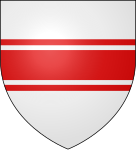 Fess cottised
Fess cottised -
 Two barrulets
Two barrulets -
 Two bars gemelles
Two bars gemelles -
 Fess indented
Fess indented -
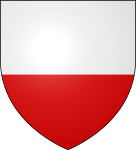 Party per fess
Party per fess -
 Barry of eight
Barry of eight -
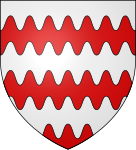 Barry wavy
Barry wavy -
 Barry nebuly
Barry nebuly
Diminutives
In English heraldry, two or more such charges appearing together on a shield are termed bars, though there are no definitive rules setting the width of the fess, the bar, nor their comparative width.[3] A shield of (often six or eight) horizontal stripes of alternating colour is called barry. Narrower versions of the bar are called barrulets ("little bars"), and when a shield of horizontal stripes alternating colour is composed of ten or more stripes, it is called barruly or burely instead of barry.[3] A cotise, defined as half the width of a barrulet, may be borne alongside a fess, and often two of these appear, one on either side of the fess.[3] This is often termed "a fess cotised" (also cottised, coticed or cotticed).[5] Another diminutive of the fess called a closet is said to be between a bar and barrulet, but this is seldom found.[3]
Other uses
-
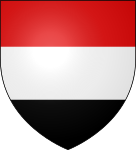 Tierced per fess
Tierced per fess -
 Three eagles in fess
Three eagles in fess -
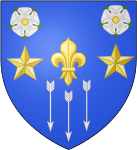 A fleur-de-lys between two mullets in fess
A fleur-de-lys between two mullets in fess - A flaming arrow fesswise
A shield party per fess (or simply per fess) is divided in half horizontally (in the manner of a fess). A charge placed horizontally may be termed fesswise or fessways, and two or more charges arranged in a horizontal row are blazoned in fess or in bar.
Notable and unusual forms
A mural fess, that is a fess embattled and masoned of the field, can be seen in the arms of Suzanne Elizabeth Altvater.[6]
The arms of Rennie Fritchie, Baroness Fritchie provide an example of three Barrulets fracted and there conjoined to a Chevronel.[7]
A flag which has a central horizontal stripe that is half the height of the flag is sometimes said to have a Spanish fess. The name is based on the most well-known example of this style of flag, the flag of Spain.
See also
- Bar (heraldry)
Notes
- ^ Fouché, Pierre (1961). Phonétique historique du français (in French). Vol. III: Les Consonnes et index général. Paris: Klincksieck. p. 921.
- ^ "Fess 1". American Heritage Dictionary of the English Language, 4th ed. Houghton Mifflin Company. 2000. Archived from the original on 2005-09-26. Retrieved 2009-03-29.
- ^ a b c d e Woodcock & Robinson (1988), Oxford Guide to Heraldry, p. 60.
- ^ Woodcock & Robinson (1988), Oxford Guide to Heraldry, p. 58.
- ^ Parker, James (1894). "Cottise". A Glossary of Terms Used in Heraldry. Retrieved 2009-03-29.
- ^ "Suzanne Elizabeth Altvater Grant of Arms". The Public Register of Arms, Flags and Badges of Canada. The Canadian Heraldic Authority. 1998-10-29. Archived from the original on Jul 28, 2016. Retrieved 2009-03-29.
- ^ "Heraldry of New Life Peers". The Heraldry Gazette (June 2007). The Heraldry Society: 3. 2007-11-24. Archived from the original on Jan 10, 2014. Retrieved 2009-03-29.
Further reading

- Boutell, Charles (1890). Heraldry, Ancient and Modern: Including Boutell's Heraldry. London: Frederick Warne. OCLC 6102523
- Fox-Davies, Arthur Charles (1909). A Complete Guide to Heraldry. New York: Dodge Pub. Co. ISBN 0-517-26643-1. LCCN 09-23803
- Neubecker, Ottfried (1976). Heraldry: Sources, Symbols and Meaning. Maidenhead, England: McGraw-Hill. ISBN 0-07-046312-3.
- Volborth, Carl-Alexander von (1981). Heraldry: Customs, Rules and Styles. Poole, England: Blandford Press. ISBN 0-7137-0940-5. LCCN 81-670212
- Woodcock, Thomas and John Martin Robinson (1988). The Oxford Guide to Heraldry. Oxford: University Press. ISBN 0-19-211658-4. LCCN 88-23554
- Woodward, John and George Burnett (1892). Woodward's a treatise on heraldry, British and foreign. Edinburgh: W. & A. K. Johnson. ISBN 0-7153-4464-1. LCCN 02-20303
- v
- t
- e
- Authorities
- Grant of arms
- History
- Law of arms
- Officers of arms
- Armiger
- Augmentation
- abatement
- Ancient and modern
- Alliance
- Blazon
- Cadency
- Canting
- Field
- Fraud
- Marshalling
- quartering
- impalement
- National traditions
- Societies
- Coat of arms
- Crowns and coronets
- Crest
- Compartment
- Escutcheon
- Helmet
- Mantling
- pavilion
- Motto
- slogan
- Supporter
- Torse
- Attitudes
- Erasure
- Fimbriation
- Lines
| Ordinaries | |
|---|---|
| Beasts | |
| Birds | |
| Other |
|
| Legendary |
|
| Plants | |
| Knots |
- Rule of tincture
- Tricking
- Hatching
| Metals |
|
|---|---|
| Colours | |
| Furs | |
| Stains | |
| Rare metals1 |
|
| Rare colours1 |
|
| Realistic |
|
- 1 Non-traditional, regional, or rarely used (sometimes considered unheraldic)
- List of oldest heraldry
 Heraldry portal
Heraldry portal - resources
























